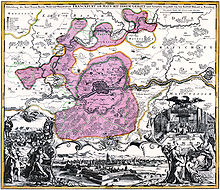
(copperplate by Johann Baptist Homann, regional boundaries corrected by Friedrich Bothe)

The terms landwehr ("land defence"), landgraben ("land ditch") and landhege ("land enclosure") refer to border demarcations or border defences and enclosures in Central Europe that were either built by settlements with the right of enclosure or to mark and defend entire territories. These measures, usually comprising earthworks or dykes as well as ditches and impenetrable lines of hedging, for protecting towns and villages date mainly to the High and Late Middle Ages and consist, in some cases, of systems over a hundred kilometres long. Comparable earthworks have been recorded since Antiquity.[1] The Roman limes are the best known examples of earlier landwehrs. The Danewerk is another example of this type of barrier.
Many of these landwehrs have survived, especially in woods and forests, and are often protected as heritage sites.
- ^ Martin Kollmann: Landwehren. In: Romerike Berge. Solingen. 57. Jahrgang, 2007, Heft 1, p. 27–41